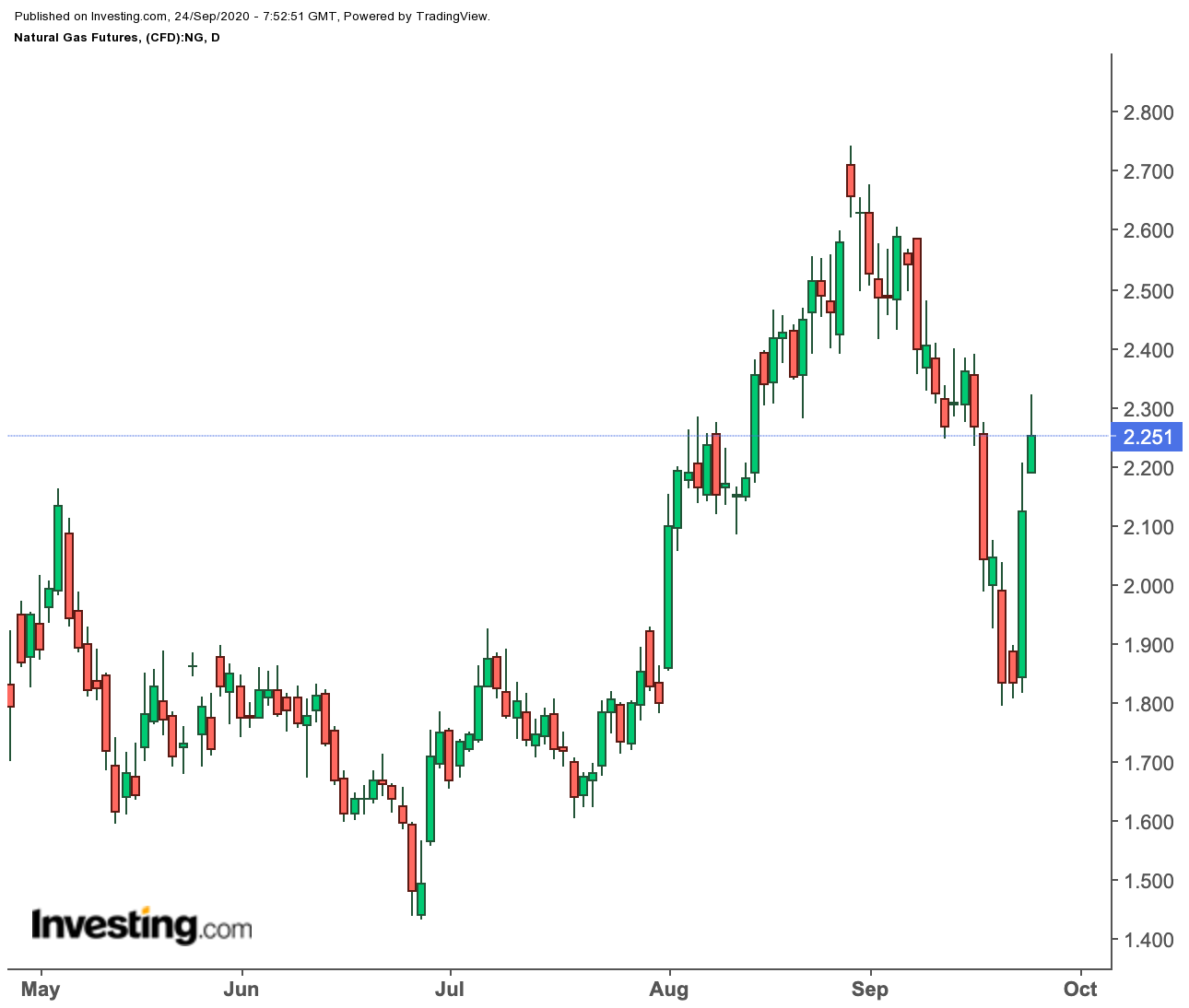It’s the million-dollar question in the natural gas market, though the argument itself is over $2—and whether that will hold as the base price for the fuel going into the cold season.
Against the wildest expectations of many, the front-month October gas contract on New York Mercantile Exchange’s Henry Hub jumped 16% on Wednesday for a triumphant return to the $2 per mmBtu, or million metric British thermal units, mark.
It was an epic reversal of Monday’s shock plunge that wiped out over 10% in the price of the fuel burned by utilities across America to generate power for air-conditioning in the summer and heating in the winter.
In the action that unfolded at the start of the week, October gas lost 21 cents, falling to a two-month low of $1.795 per mmBtu. In the latest session, however, Henry Hub’s benchmark contract gained 29 cents, more than making up for the deficit.

Markets tend to overreact in correcting any overbought or oversold position, and Wednesday’s rebound in gas fits that narrative.
Significant Build Looming
But there’s still a problem for gas bulls: another significant supply build likely got added to inventories last week.
And once that number is released to the market today, it could pressure prices again.
As of Wednesday, the trade’s bet is that 78 billion cubic feet got added to gas storage last week, versus the 89 bcf in the previous week. The U.S. Energy Information Administration’s weekly gas inventory report, due at 10:30 AM ET (14:30 GMT), will show how accurate or otherwise the market is with that call.
Ahead of the EIA report, Henry Hub opened Thursday’s pre-New York session at $2.195 per mmBtu. It hovered during early afternoon hours in Singapore at between $2.185 and $2.216.
If the build reported by the EIA for the week ended Sept. 18 breaches 80 bcf, or is closer to 100 bcf, will the $2 support hold?
That will depend on several variables.
Dan Myers, analyst at Houston-based gas risk consultancy Gelber & Associates, said in an email to the firm’s clients, seen by Investing.com:
“The weight of this heavy storage surplus will ultimately lead to an adjustment in coming month contracts, and it is a question of how far into the season the market can maintain its winter premium.”
Buyers Are Already Piling In For Winter Gas
While storage may be looking top-heavy, there are caveats to consider, says Myers.
One is that despite less-than-stellar fundamentals and a lack of cold weather to sustain heating demand, buyers were already piling into winter gas contracts, he explained.
The peculiarity that struck him most was Henry Hub’s November contract, which, at Wednesday’s settlement of $2.633, was at a premium of around 60 cents to October, the benchmark.
Myers calls it “the largest absolute front to second month spread since early 2014.”
He adds:
“So far, worries of overfull storage have mostly only been a drag on the front month, with anticipation that injection rates will need to slow in certain regions (particularly the South Central) next month, battering spot prices.”
“However … there is still plenty of room in most regions before demonstrated peak capacity above 4.25 trillion cubic feet nationally. This suggests that injections will be able to keep a high rate and could help inventories near 4 tcf as early as mid-October.”
And what do weather patterns say?
Dominick Chirichella, director of risk and trading at Energy Management Institute in New York, said over the next few days warmer-than-normal temperatures were expected to become more widespread from the Midwest into the Northeast, and expand into the Southeast by the weekend.
Unseasonable warmth in the West is forecast to continue during the 6-10 day period, leading to warmer trends for the West but cooler patches for the central and eastern U.S., where gas-fired heating is more prevalent.
The eastern half of the nation, thus, could get an “impressive early shot of chill” that might get furnaces running, while heat in California and the Southwest continues to drive air-conditioner use, Bespoke Weather Services said, concurring with Chirichella.
Together, the outlook “is enough to place demand above normal next week on the national level”, it added.
Disclaimer: Barani Krishnan does not have a position in the commodities or securities he writes about.
